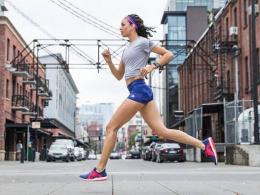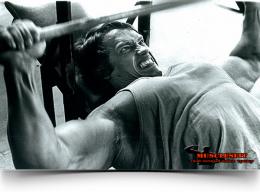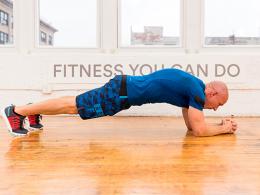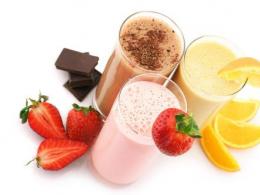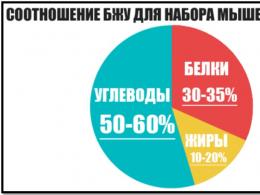How to pump up your arms? Complete download guide. .
Greetings, my dear! Today we will continue our epic cycle of notes on pumping issues and consider a thematic note with the title - how to pump up your arms? As usual, first we will lay all the necessary theoretical foundation - we will go through anatomy and kinesiology, and then we will get into practice - we will consider the best hand training programs.
So take your seats, we're about to begin.
How to pump up your arms? The theoretical side of the issue.
This is the second note from a similar cycle, in the first we considered the muscle groups of the delta and dealt with the issues of its buildup, therefore, if you have not yet testified your respect for this creation :), then please do so by clicking on the link. In this article, we will deal with our pens. I must say right away that the calculations below are true for both sexes, and the ladies will also be able to improve this problem area of theirs - to make it more toned, pumped up and embossed, therefore, ladies, we also wind the information on our heads (or not, you don’t have a mustache, you can use your hair :). Well, actually quite pouring water, let's get down to the point.
Note:
For better assimilation of the material, all further narration will be divided into subchapters.
Hand anatomy and muscle atlas
Hands are a rather small, but very indicative muscle group, in which two parts can be conditionally distinguished:
- anterior (25% hand size)- biceps, brachial (brachialis), brachioradialis (brachiradialis);
- rear (75% hand size)- triceps triceps muscle with 3 heads long, lateral and medial.

Let's dwell on each muscle in a little more detail and start with ...
I. Front of the arm
The muscles of the front of the hand include:
No. 1. Biceps
The biceps muscle of the shoulder, consisting of a short and long heads. The first attaches to the front of the scapula and crosses the arm down to the radius, the second originates from the scapula but takes a longer route, also attaching to the radius.
No. 2. Brachialis
It starts in the middle of the humerus and runs down it and attaches to the other bone of the forearm. The brachialis is not involved in pronation or supination of the arm and its main role is to assist in elbow flexion.
Number 3. Brachyradialis
A muscle of the forearm that originates on the humerus and inserts at the end of the radius.
The front part of the arm in assembled form is the following picture.
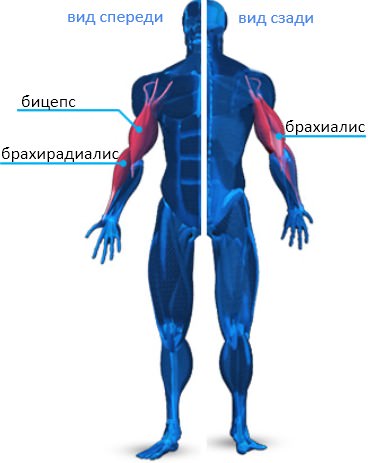
II. back of hand
The muscles of the back of the hand include:
Triceps
The triceps muscle of the shoulder, the developed heads of which form the shape of a horseshoe. The anatomy of the triceps includes three heads - lateral, medial and long. The first runs from the humerus down the arm and attaches to a structure called the olecranon. The second one starts on the back of the humerus and attaches to your elbow. The third runs from the scapula in the region of the humerus and goes down to the olecranon. Because of this scapular attachment, you can move your arm and shoulder slightly backward to isolate the muscles.
The work of the biceps and triceps muscles in the exercises is clearly demonstrated by the following image.
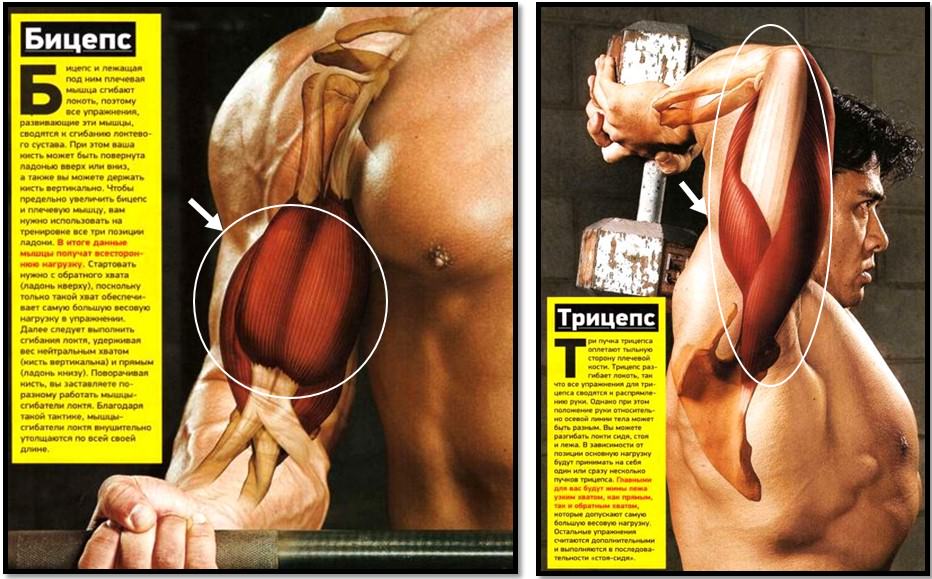
A complete muscle atlas of the muscles of the hands is such a picture.
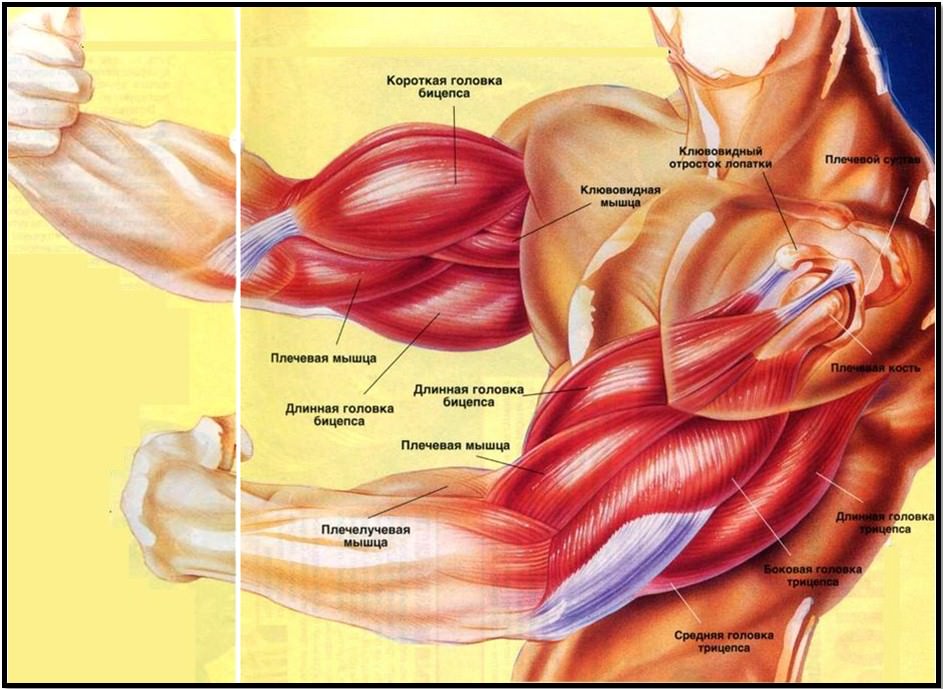
Skeletal anatomy
Bones and joints play an important role in arm movement. Understanding how they work will help you better select exercises and maximize the involvement of target muscles in the work.
Three important key joints in the front of the arm that affect bicep training are: the shoulder, elbow, and wrist joints. All of them are tied in movements during arm training and each performs its function, the ulnar one is involved in the rotation / rotation of the arms and flexion of the elbow joint when lifting the biceps, the shoulder joint is crossed by the long head of the biceps, the carpal one changes the position of the forearms and is responsible for the movements of pronation and supination.
These same joints are important when training the triceps. When the arm is raised above the head, the shoulder joint and the long head of the triceps are included in the work, which stretches and contracts during movement. Straightening the arm, for example, in exercises such as the triceps extension requires extension of the elbow joint.
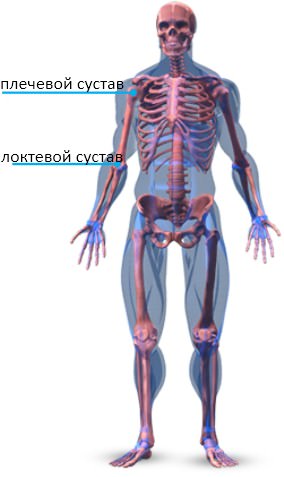
Muscle functions in practice
It is important not only to know how the hands are arranged, it is important to know their functions using real movements as an example, i.e. how muscles, bones and joints work together in weight training in the gym. And we'll start with...
I. Front of the arm
During the work of the front of the arm, the rotation of the hand allows you to “hook” different elbow flexor muscles. In total, there are three options for gripping dumbbells:
No. 1. Supination
Supination is a rotational movement in which the palm is facing up. When lifting dumbbells, the biceps helps to flex and supinate the arms. When this grip is used, the biceps brachii receives the most beneficial load and works more efficiently.
No. 2. Neutral grip
A neutral grip is when the hands are facing each other. This position is most beneficial for the development of brachialis, for example, when lifting a dumbbell with a hammer grip.
Number 3. Pronation
Rotational movement of the hand, in which the palms are facing down. Pronation automatically relieves stress on the biceps. This position is most beneficial for the development of brachiradialis, for example, when lifting a dumbbell with a reverse grip.
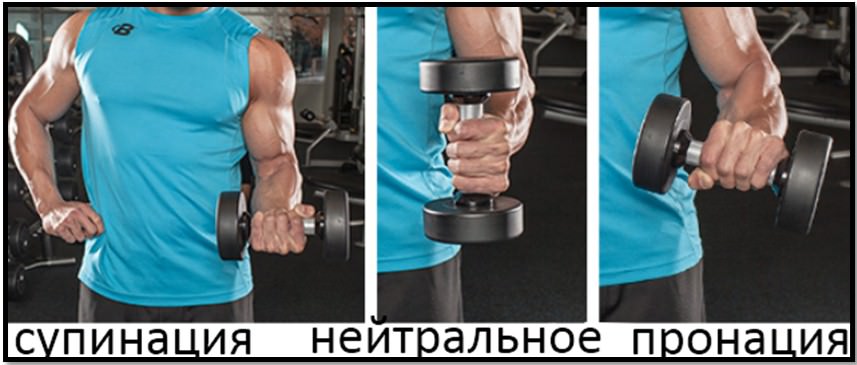
II. back of hand
The main functions of the back of the arm are extension/flexion of the elbow and extension/flexion of the elbow behind the head. When the first movement occurs, everyone is equally involved in the work. 3 triceps heads. When raising the arm above the head, the emphasis shifts to the long head of the triceps.
Note:
The long head is named so for a reason, it really is the largest, and so is its contribution to the volume of the hand.
From the foregoing, the following conclusions can be drawn.
In order for the biceps to receive a comprehensive load, you need to perform exercises with different grips, and you need to start training with a supinated grip (because it provides the largest weight bearing), then change the grip to neutral and finish off, taking the dumbbell / barbell with a pronated grip.
As for the triceps, the most effective strategy for working it out is to use different positions of the arm relative to the centerline of the body - sitting, standing and lying down. Moreover, the triceps muscle of the shoulder receives the largest weight load during bench presses. (narrow grip/French press), so they need to be put at the beginning of the workout. The remaining auxiliary exercises should be those in which the athlete is in standing-sitting positions.
So, we go directly to the pumping-theoretical side of the issue.
How to pump up your arms? Theory of swing.
The following information is purely exclusive, and I came across it while studying ancient files (already for 1993 year) American scientific fitness magazines. Now we will learn how to swing arms from a scientific and anatomical point of view.
Hand kinesiology or what you need to know to pump up huge hands?
The very movement of the arm from full extension to full compression is carried out by means of 4 -x muscles working together, duplicating work. The brachiradialis begins the lifting movement due to its location on the arm. After that, the biceps is included in the work, then the “control” is transferred to an area called the brachialis, which completes the movement of the arm, its flexion.
In bodybuilding, it is important to know when each muscle starts and stops working, because. this understanding allows you to achieve better results in the development of muscles. Thus, in any exercise (in this case by hand) There are strong and weak parts of the movement. Cheating weak links means that you are jumping over a part of the muscle without giving it the necessary load and the necessary stimulus for growth. Such deception (cheating) does not allow a certain area of \u200b\u200bhands to grow properly. Therefore, it is extremely important for building large biceps to observe the ideal technique when performing exercises.
The question you should ask yourself, for example, when lifting dumbbells for biceps: “Do you want to just move the weight from point A to point B, or do you want a full biceps workout and big arms?”. When it comes to moving a limb, some muscles do a better job than others depending on where they are in relation to the joints.
In the figure, the brachiradialis is close to the elbow, which is a good position to start the full extension movement. After the movement begins, the biceps and brachialis take over the loads, starting from certain lifting angles. The biceps is the main driving force, but it is assisted by the brachialis (in flexion) and brachiradialis (in extension). Thus, both muscles perform the middle part of the movement - first the biceps starts, then the brachialis, which completes the flexion of the arm.
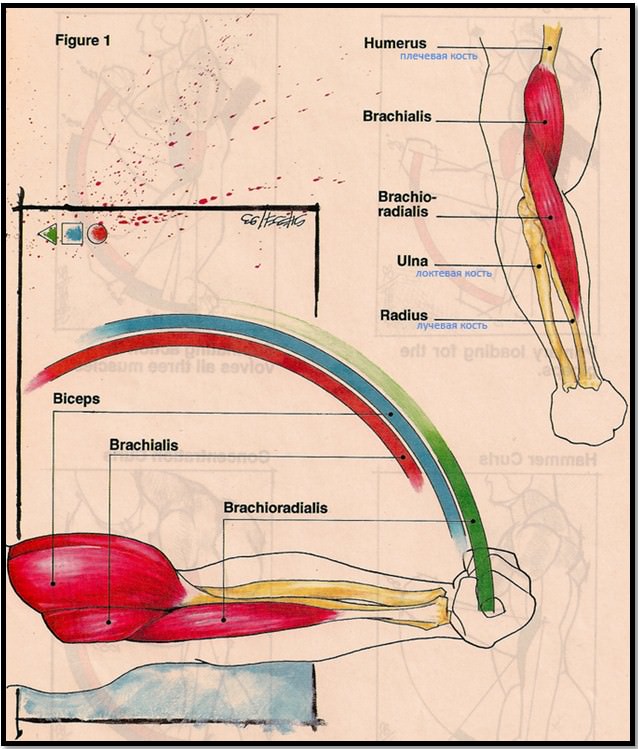
The conclusion from all of the above is that each muscle has a certain range of work, and for an athlete who decides to build massive arms, it is important to understand which exercises, which areas of movement / areas of the arms, capture.
Let's take a look at the exercises. (and the order in which they follow each other) in order to maximize the involvement of different areas of the muscles of the hands in the work.
Exercise #1
Lifting the barbell for biceps, straight neck - a basic exercise that must be performed first in training for mass. The entire load falls on the biceps of the shoulder. The nuance is starting from a position in 10 degrees, i.e. at the bottom point, do not fully extend your arms. Then you need to focus on exercises for various muscles of the biceps. (meaning brachial / brachial) and do them in a specific range of motion.
Exercise #2
Straight Bar Scott Bench Extension is the best exercise to focus on 2 heads of the biceps. The range in which you will work from 15-30 and reaching 105 degrees. It is he (such an angular range) provides maximum loading of the biceps of the shoulder.
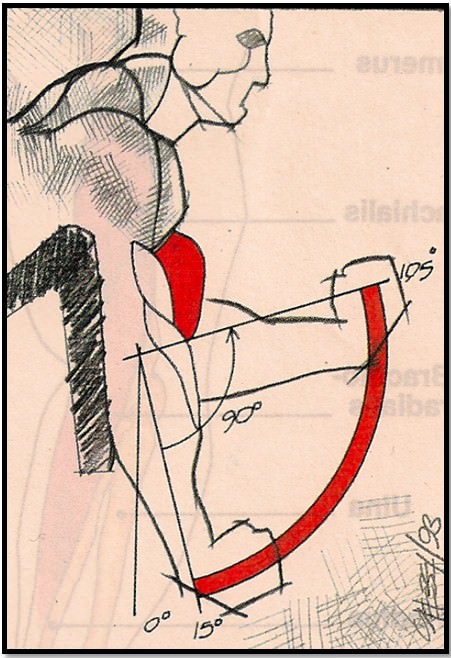
Exercise #3
Rotation / supination when lifting dumbbells, sitting on a bench (lifting dumbbells with turning the hands). Sit on a bench with an upward slope, in this position the biceps will be stretched as much as possible. The starting position is the pronated grip of the dumbbells, then they turn and supinate.

The supinating action allows you to involve all three muscles - biceps, brachialis and brachiradialis.
Exercise #4
The Dumbbell Concentrated Curl is an exercise that works the brachialis, which in turn pushes the biceps out and creates a peak. The main work begins with 15-30 degrees and continues until 120 , the final phase of bending the arm. The key point in the exercise is a slight turn of the hand at the very beginning of the movement. Do not lower your hand all the way down, but start from the corner in 15-30 degrees, and then keep the tension in the muscles throughout the upward movement.
![]()
Exercise #5
Hammer raises - can be the final exercise in training the muscles of the arms (biceps). The main "driver" is the brachiradialis. Dumbbell lifts should be carried out slowly and under control, bringing the arm to the corner in 90 degrees. The weakness of this muscle takes away the size of the biceps, so it makes sense to deal with its development through the appropriate exercise.
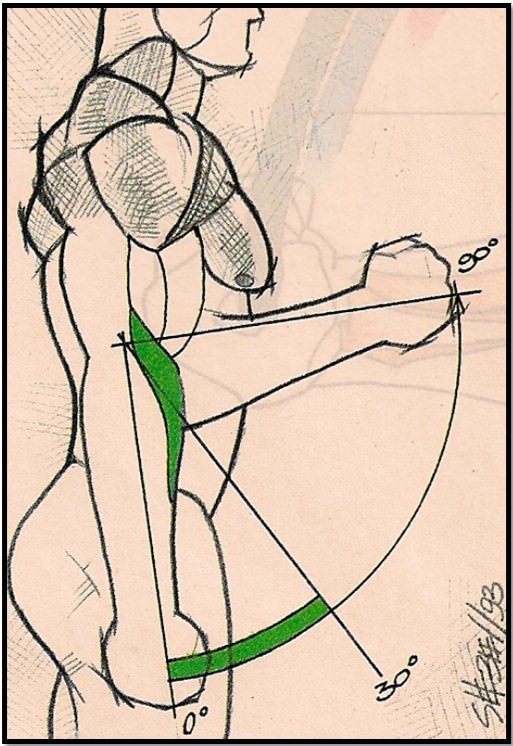
Well, here, in fact, that’s all in theory, we will consider the specific program part and practical aspects of the training in the second part of the note, so we don’t diverge far, to be continued ... as they say.
Afterword
Another seriously pumping note has come to an end, yes, not everything has been sorted out, or rather, there is no main thing, practice, but we are not saying goodbye, right? And we say to each other "until we meet again." See you in the second part, we are waiting, sir, soon on all TVs in the country :)!
PS. and what chips do you use when training biceps, prick!
P.P.S.
With respect and gratitude, Dmitry Protasov.

